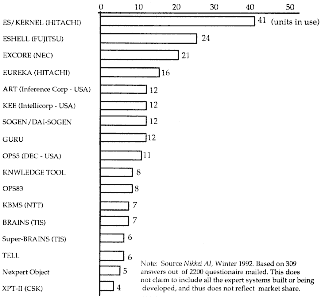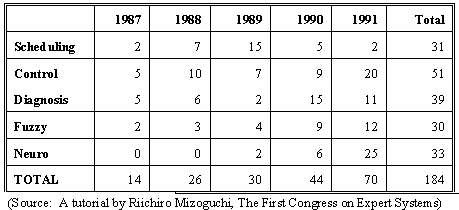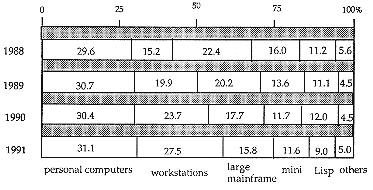http://www.wtec.org/loyola/kb/c3_s2.htm
An expert system tool, or shell, is a software development environment containing the basic components of expert systems. Associated with a shell is a prescribed method for building applications by configuring and instantiating these components. Some of the generic components of a shell are shown in Figure 3.1 and described below. The core components of expert systems are the knowledge base and the reasoning engine.
Figure 3.1. Basic Components of Expert System Tools
1. Knowledge base: A store of factual and heuristic knowledge. An ES tool provides one or more knowledge representation schemes for expressing knowledge about the application domain. Some tools use both frames (objects) and IF-THEN rules. In PROLOG the knowledge is represented as logical statements.
2. Reasoning engine: Inference mechanisms for manipulating the symbolic information and knowledge in the knowledge base to form a line of reasoning in solving a problem. The inference mechanism can range from simple modus ponens backward chaining of IF-THEN rules to case-based reasoning.
3. Knowledge acquisition subsystem: A subsystem to help experts build knowledge bases. Collecting knowledge needed to solve problems and build the knowledge base continues to be the biggest bottleneck in building expert systems.
4. Explanation subsystem: A subsystem that explains the system's actions. The explanation can range from how the final or intermediate solutions were arrived at to justifying the need for additional data.
5. User interface: The means of communication with the user. The user interface is generally not a part of the ES technology, and was not given much attention in the past. However, it is now widely accepted that the user interface can make a critical difference in the perceived utility of a system regardless of the system's performance.
The following subsections survey Japanese ES tools that are on the market, observe current trends in tool development, and comment on the recent integration of fuzzy logic and neural networks into these tools. Finally, we describe in more detail one of the latest Japanese tools, ES/KERNEL2.

ES Building Tools on the Market
Traditionally, ES tools have been categorized by their hardware platform: PC- or Macintosh-based, workstation-based, or mainframe-based. (For example, see Harmon 1992a).
Recently, new types of tools have come on the market that are characterized according to tasks (e.g., diagnosis, planning) and problem-solving approaches (e.g., case-based reasoning or model based reasoning). These second generation tools encode the problem-solving know-how gained through building applications in different areas using the first generation tools. The emergence of such tools reflects the market condition in which vertical tools are perceived to be easier to use and easier to sell. A problem-specific, or task-specific, tool contains knowledge representation schemes and reasoning methods found useful for a particular class of applications and a task ontology associated with the problem class.
Table 3.1 lists most of the commercial tools developed in Japan. They are broadly categorized as general purpose, task-specific, solution-specific, and development methodology tools (i.e., tools for training implementors in the methodology for developing expert systems). There are also more general-purpose tools on the market than the list might indicate. A general purpose tool such as ES/KERNEL represents a class of tools, with a version of the tool for different types of hardware platforms -- ES/KERNEL/W for workstations; ES/KERNEL/H for mainframes and super-computers; ES/KERNEL/P for the personal computers; and ES/KERNEL/D for on-line data processing.
In addition to the tools developed by the Japanese, foreign-made tools, primarily American, make up about 30 percent of the tools used in fielded expert systems in Japan. This JTEC panel is not aware of any Japanese tools being sold in the U.S. Components of the next version of ES/KERNEL -- ES/KERNEL2 -- are being developed in Europe and will be marketed there. Figure 3.2 shows the relative popularity of the more common tools in use. The four most popular tools are those developed by domestic computer manufacturers, Hitachi, Fujitsu, and NEC. According to Nikkei AI, these tools are popular primarily because they can be used on hardware the customers already have. Tools that run on multiple platforms (mainframe, workstations, and PCs), such as ES/KERNEL and ESHELL, have been particularly popular. The decision to use American and small-vendor tools are generally made based on their features and capabilities rather than the platforms on which they run.
Figure 3.2. Expert System Tools in Use in Japan
In its 1991 annual survey of fielded expert systems, Nikkei AI reported 48 applications developed with ES/KERNEL and 47 with ESHELL. Up until 1991, ESHELL was the dominant tool. In 1992, ES/KERNEL had overtaken ESHELL by a wide margin (Figure 3.2). ESHELL is considered to contain more advanced AI techniques, but ES/KERNEL is considered more practical and easier to use. Sales of these tools are affected by the platform on which they run and the base language used to write the system. The ESHELL family -- ESHELL (mainframe), ESHELL/X (mainframe and workstation), ESHELL/FM (personal computer), ESHELL/SB (minicomputer) -- are written in UTiLisp (University of Tokyo Interactive Lisp, quite archaic by present standards). ES/KERNEL runs on UNIX workstations and is written in C. The rising popularity of workstation tools and the drop in the sales of mainframe tools correlate with the general trend in the United States. The move to workstations in the U.S. is ironic since the tools were originally developed on workstations. Of course, today's workstation environment is quite different from the earlier days.


Market Trends
As will be seen, the trends in the type of ES building tools that have been, and will be, on the market are generally the same for both Japan and the U.S. In contrast, machine learning tools are receiving much more attention in Europe than in either Japan or the U.S. Up to now, the basic technology base of both the Japanese and American tools originated in U.S. laboratories; the tools of the two countries have have more in common than not. The following is a description of some of the trends the JTEC team observed that relate to tool technology.
Specialization of tools. Most first generation, general-purpose tools were built and marketed by the information systems divisions of large computer companies. The same groups are also developing second-generation, task-specific tools. These specialized tools are also beginning to be developed and sold by engineers servicing the end-user community. For example, the fourth most widely used tool, EUREKA, was built by the Heavy Industry Division of Hitachi as a tool to build real-time process control systems. MEL-DASH (Komai, Matsumoto et al. 1991), a special tool for diagnosing electrical network faults, is being built by a group at Mitsubishi Electric's Industrial Systems Laboratory specializing in the electric power industry.
There are two underlying impetuses for developing task-specific tools. First, with a task-specific tool, the knowledge acquisition subsystem can be tailored to the particular class of problems for which the tool is intended, making knowledge acquisition easier for the application developer. The reasoning engine can also be customized to the task, making the system more efficient. The developers of MEL-DASH claim that specialization also allows them to build tools with a reusable library of software components and verification tools. Second, a task-specific tool geared to a particular end-user group's needs and ways of doing things is a good way to encourage use of the technology. Table 3.2, for example, shows Fujitsu's strategy for expanding the market for ES technology by providing tools for divisions that service end users.
Table 3.2 also shows another way in which Fujitsu is trying to expand the ES user base. YPS/KR and FORTRAN/KR are tools targeted to the COBOL and FORTRAN user communities. FORTRAN/KR claims to provide modeling facilities such as objects, rules and a high performance inference engine with fuzzy data, for integration in the FORTRAN programming environment. The representation of knowledge for design and control makes it easy to build intelligent and complex systems using FORTRAN programming in areas such as design, scientific computation and process control (Fujitsu America Inc. 1990). FORTRAN/KR runs on Fujitsu mainframe computers and Sun workstations.
The decision to invest in the building of a task-specific tool is based on the demand for application systems in that area. Historically, diagnosis was the most popular application area for the first few years after the introduction of expert systems. Thus, diagnostic problem-solving is a well understood task area. More recently, both Fujitsu and Hitachi claim that scheduling and planning systems have become popular, and there are demands for specialized tools in these areas. Toshiba claims that design systems, especially in the area of LSI routing, are also increasingly in demand.
An interesting phenomenon is the popularity of Hitachi's EUREKA, a tool for developing real-time control systems. It outsells domain shells in all other task areas, even though the number of real-time control systems being built is much smaller than other types of applications. Table 3.3 shows the actual numbers of applications developed by the top five companies using ES technology. There is a surge in 1991 in the use of control programs that go hand in hand with the increase in the use of neural networks. (The use of neural networks in conjunction with expert systems is described later in this chapter.)
Table 3.3
ES Development History of Top 5 ES-User Companies:
Number of Applications by Year
The popularity of EUREKA parallels the rising popularity in the United States of G2, a real-time control system tool developed by GENSYM. (However, the use of neural networks in control systems is still rare in the United States.)
Table 3.3 also shows that companies that successfully deploy expert systems are repeat users.
In addition to the tools sold by ES tool vendors, large companies are developing their own tools for specific task areas, which reflect what they have learned through their experiences. Company-specific processes and proprietary knowledge can be built into a tool and disseminated within the organization. Or, as at the Shimadzu Corp., the software system can be sold as part of, or a supplement to, a product line. Shimadzu Corp. produces general analysis and medical diagnostic devices. To build diagnostic and usage guidance software systems, the company developed GENZO-I, an analysis tool useful for diagnostic, classification, and interpretation tasks. GENZO-II, a hybrid tool using frames and rules, is used for synthesis problems such as planning and design (Hasegawa et al. 1991; Takata et al. 1991).
Workstation tools. Early developers of expert systems used American tools and LISP workstations to develop their applications. For example, Nippon Life Insurance developed its underwriting advisory system using KEE (KEE is a trademark of Intellicorp, Inc.) on the Symbolics workstation. Most early ES tools developed by the Japanese were for mainframes. It may be that the Japanese were forced to develop mainframe tools because there were none available at the time. Until recently, the ESHELL line, a mainframe-based tool, was the best-selling line.
In the United States, a shift towards open, client-server architectures began to have a noticeable effect on the tools market beginning in early 1990, when there was a dramatic increase in the sale of tools on UNIX-based workstations. Sales jumped from around 3500 units in both 1988 and 1989 to 6900 units in 1990 (Harmon 1992b). Although there is no comparable figure for Japan in terms of the actual number of tools sold, Nikkei AI, in its 1991 survey, noted an increase in the percentage of UNIX workstations used as the ES platform, and an accompanying decrease in the use of mainframe systems (see Figure 3.3). Hitachi representatives believe that the sudden popularity of Hitachi's ES/KERNEL can be attributed to the increased popularity of UNIX workstations in Japan. Of the more than 4,000 units of ES/KERNEL sold since 1987, 2,000 were sold in the last two years.
Embedded systems and system integration. In the early exploratory period, expert systems were stand-alone systems solving isolated problems. As customer confidence grew in the ability of ES technology to deliver solutions, expert systems were incorporated in larger systems. Knowledge representation and reasoning tools were augmented with tools to access databases, to interface with existing programs, and to operate in a mainframe environment. In many cases, especially with mainframe-oriented tools, the expert system component became a part of larger systems. Today, embeddability -- the ability to operate within many different environments and in concert with a variety of other software -- is a crucial aspect of expert systems and their development tools.
Figure 3.3. Changes in the Hardware Types Used for ES Development
Note: "Others" Include PROLOG Machines. (Source: Nikkei AI 1991)
At the outset, computer companies were active in building ES applications. System engineers trained in the use of ES technology regarded expert system technology as merely another software methodology. Thus, from the beginning they addressed the problems of system integration and development methodology. Fujitsu's ESHELL, until recently the number one seller, was based on a blackboard architecture which facilitated integration. Fujitsu software engineers were also able to adapt, for better or for worse, the waterfall model of software development to ES development. Hitachi's ES/GUIDE, which contains a step-by-step guide to ES development, draws heavily on the spiral model of software development process combined with the waterfall model to handle the documentation process. All this indicates that the Japanese have already made substantial investment, and have a broad experience base, in the process of ES development. Combined with their early experience in building expert systems on mainframe computers and in integrating expert systems with other systems, Japanese software engineers seem well prepared for building large expert systems and conventional systems containing expert system components.



Novel Features: Fuzzy Logic and Neural Networks
Most ES tools contain similar features. Knowledge is generally represented as IF-THEN rules, and in newer tools knowledge can also be represented as frames. The reasoning methods include forward chaining and backward chaining. And, most tools have facilities for generating explanations of the application programs' reasoning. Japanese ES tools are technically indistinguishable from U.S. tools, except in three areas: the user interface, which is to be expected; the extensive use of fuzzy logic (or multi-valued logic) to express inexactness; and connections to neural networks.
In the most general sense, fuzzy logic, invented by Lotfi Zadeh (Zadeh 1965), is a multi-valued logic to express different degrees of certainty or uncertainty of assertions. Since expert systems contain heuristic knowledge, they must have a way of dealing with the problem of expressing and reasoning with uncertain data and inexact knowledge. Among the Japanese, fuzzy logic is an extremely popular solution for this problem. It is most popular among control engineers. The first significant use of fuzzy logic was in a Hitachi-built expert system that controlled the brakes on passenger trains (Yasunobu and Miyamoto 1985). Recently, fuzzy control has been used in consumer products -- for example, fuzzy rice cookers, fuzzy washing machines, fuzzy camcorders. Mitsubishi's fuzzy elevator system, described in Chapter 2, reduces the waiting time at floors.
A neural network is typically used as a pre-processor to process signal data for process control and manufacturing systems. The neural net converts signals into symbolic information that can be reasoned by expert systems. The SAFIA system shown in Figure 3.4 is an example of a typical process control program with a neural network front-end. Nippon Steel's SAFIA, built with Hitachi's EUREKA and Nippon Steel's own neuro-simulator AMI, controls the operation of the blast furnace. Typically, such expert systems are integrated with other types of software -- for example, a database management system, a user interface, and/or a statistical analysis package -- to create integrated control systems.
Начало